Mallayeva Mavjudaxon Maxramovna1, 2, Mustafakulov Mukhammadjon Abduvaliyevich2, 3
1Samarkand State Medical University, Samarkand, Uzbekistan
2Jizzakh Branch of the National University of Uzbekistan, Jizzakh, Uzbekistan
3Institute of Biophysics and Biochemistry, Uzbekistan
Copyright © 2025 The Author(s). Published by Scientific & Academic Publishing.
This work is licensed under the Creative Commons Attribution International License (CC BY).
http://creativecommons.org/licenses/by/4.0/

Abstract
As a result of the development of industrial technologies and changes in the ecological environment, various xenobiotics released into the environment are increasing. Increasing exposure to xenobiotics may lead to the development of diseases associated with toxic hepatitis (TG) in the population. The following exogenous factors can cause TG: industrial and household toxic substances, chlorinated hydrocarbons, naphthalene and biphenyls, benzene, metals and other inorganic elements, monomers used for the production of polymer materials, plastics, hydrazine and its derivatives, as well as dioxins and radionuclides. All of these exogenous toxins have a cumulative damaging effect on the liver, so they must be converted into non-toxic compounds for the body and eliminated. The main mechanisms of toxic damage to the liver are lipid peroxidation, protein denaturation, reduction of ATF, mitochondrial dysfunction, inhibition of membrane receptors.
Keywords:
Hepatitis, Hepatotoxic, Metabolism, Tetrachloromethane, Mitochondria, mPTP
Cite this paper: Mallayeva Mavjudaxon Maxramovna, Mustafakulov Mukhammadjon Abduvaliyevich, Effect of Quercetin, Glabra and Sumax Polyphenols on Mitochondral Transmission Channels (mPTP) Channels Induced by Ca2+ Ions in a Toxic Hepatitis Model, International Journal of Genetic Engineering, Vol. 13 No. 6, 2025, pp. 124-129. doi: 10.5923/j.ijge.20251306.08.
1. Introduction
The liver plays a major role in every stage of metabolism and, together with other systems, is responsible for the adequate response of the body to external and internal changes. Today, despite the success achieved in the prevention and treatment of many diseases, the incidence and mortality rate of liver diseases shows a steady growth trend. Due to the increased exposure to environmental factors, the increasing amount of industrial and chemical synthesis products, hepatoprotectors, which increase the resistance of the liver to the effects of chemicals and normalize the functions of the response to toxic stress, are becoming increasingly important [1-2]. Hepatotoxicants have different mechanisms of action, depending on which group they belong to. In general, their harmful effect consists of changing the membrane and enzyme apparatus of hepatocytes due to increased oxidation of lipids, as well as the accumulation of toxic metabolites - hepatotoxin biotransformation products. Therefore, in the case of toxic damage to the liver, first of all, antioxidant therapy is used, which limits the factors affecting the functional state of liver cell membranes and ensures their histological integrity [3-5].
2. The Purpose of the Subject
Study of the effect of polyphenolic compounds on Ca2+-induced mitochondrial permeability transition (mPTP) in toxic hepatitis.
3. Materials and Methods
Tetrachloromethane (CCl4) solution in 50% olive oil was challenged by parenteral administration twice at a dose of 2 ml/kg in 1 day [12]. Medicines Slymarin (pharmacological sales name Karsil) 50 mg/kg, sumax 10 mg/kg, glabra 10 mg/kg were administered orally within 7 days after hepatitis was induced in a dose of 10 mg/kg. Extraction of liver tissue homogenate We isolated 150-200 grams of rat liver tissue homogenate by differential centrifugation. Blood was collected from the animals, centrifuged at 3000 rpm for 12 minutes, serum was separated and biochemical indicators were studied. Alanine aminotransferase activity in serum was determined by the single Reitman-Frenkel method [6].
4. Result and Discussion
Mitochondria are the major cellular organelles that produce almost 95% of the ATF used in mammalian cells through oxidative phosphorylation. Mitochondria also play an important role in homeostasis of calcium ions. when the cytosolic Ca2+ concentration exceeds a threshold, mitochondria can rapidly accumulate Ca2+ and release it slowly. Regardless of its participation in oxidative phosphorylation, Ca2+ in mitochondria also participates in cytosolic calcium signals and activates the mitochondrial apoptosis mechanism by inducing mPTP opening in the mitochondrial inner membrane. It is widely recognized that abnormal elevations of intracellular Ca2+ can induce mitochondrial strangulation by opening the mPTP [11]. The action of prooxidant factors can cause the active opening of mitochondrial mPTP, and as a result, swelling can occur. Opening of the mitochondrial mPTP prolonged pore allows the rapid passage of ions and large molecules, which can lead to cell death. CCl4 is a toxic compound and has pro-oxidant properties. Administration of CCl4 to rats not only increases blood ALT, AST, and alkaline phosphatase enzymes, but also disrupts the exchange of calcium ions in liver cells, including mitochondria. Violation of Ca2+ retention property of mitochondria occurs in pathophysiological processes associated with energy limitation and even hepatoprotective diseases [13].In conditions of toxic hepatitis, the destruction of mitochondria can be inhibited by bioactive substances extracted from plants. The effect of selected glabra, summax polyphenols for the study on the Ca2+ ion-induced swelling of rat liver mitochondria under toxic heapatitis conditions was studied in comparative in vivo experiments with the flavonoid quercetin [11,15-19]. A very important morphological sign of mitochondrial damage is their swelling. Swelling of mitochondria is observed, for example, in myocardial cells in heart failure, in hepatitis, as well as in many infectious, hypoxic, toxic and other pathological processes. In particular, the following experiment was conducted in order to determine the correcting effect of polyphenolic compounds on liver mitochondria in conditions of toxic hepatitis (Figure 1).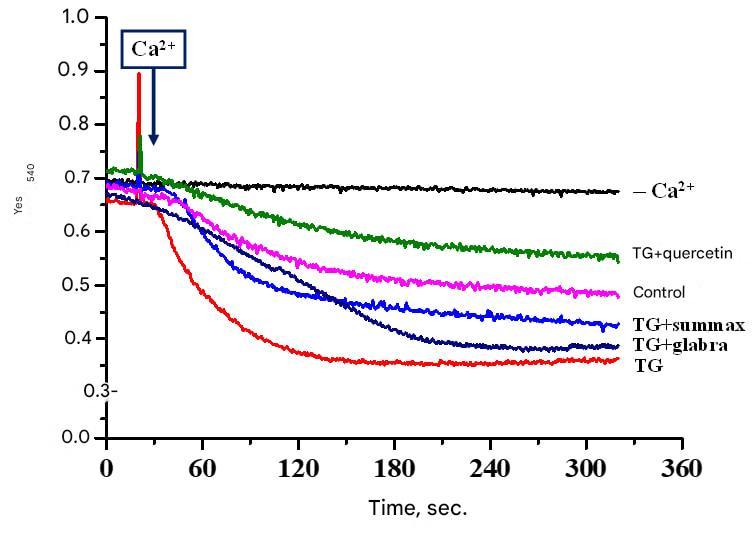 | Figure 1. Original image on effects of glabra, summax polyphenols and flavonoid quercetin on liver mitochondrial dysfunction (mPTP permeability) in CCl4-induced toxic hepatitis |
In the experiments, a concentration of 20 μM of CaCl2, which is considered as an inducer of mPTP, was used to induce mitochondrial inhibition. CaCl2-induced inhibition of liver mitochondria isolated from healthy rats (group 1) was taken as 100% as a control. According to the results, it was found that the number of liver mitochondria increased by 53.6% in 2 groups of rats with toxic hepatitis compared to the control. As a result of toxic hepatitis, an increase in Ca2+ loading of liver mitochondria and a loss of membrane stability are observed, which ensures a high permeability state of the mPTP. Original image of the effects of glabra, summax polyphenols and quercetin flavonoid on liver mitochondrial dysfunction (mPTP permeability) in CCl4-induced toxic hepatitis (Figure 1).We believe that tetrachloromethane, being a pro-oxidant compound, causes an increase in the production of ROS from the respiratory chain in mitochondria. Increased levels of ROS in mitochondria disrupt calcium signaling processes, leading to inner membrane structures including membrane LPO [20]. It causes a change in the conformation of the membrane-enhanced megachannel, and the mitochondrial matrix is irreversibly distorted. An increase in the permeability of mitochondria to water and molecules dissolved in it can lead to its swelling and a decrease in the calcium-paying capacity. Thus, an increase in the amount of ROS in mitochondria can cause a serious deficiency in the protection system against oxidative damage. LPO not only leads to increased ROS production, but can also damage mitochondrial membrane integrity and shift the mPTP to an open conformational state. The opening of MPTP plays an important role in the mechanisms of necrosis and apoptosis. In the conditions of toxic hepatitis, the opening of the hepatic mPTP releases cytochrome c from the matrix and lowers the mitochondrial membrane potential after the appearance of mitochondrial swelling. When the MPTP opens, its high permeability increases the osmotic pressure of the matrix plasma and causes the rupture of the mitochondrial outer membrane. H+ flux is the driving force for mitochondrial membrane potential and ATF production, and its change can change membrane dynamic behavior. It is evidenced that the suppression of mitochondria under the influence of Ca2+ ions in the conditions of toxic hepatitis may be based on the above-mentioned mechanisms [6-10].As a result of pharmacotherapy of group III rats with CCl4-induced toxic hepatitis with glabra polyphenol at a dose of 40 mg/kg body weight once a day for 15 days, their It was found that the number of mitochondria isolated from the liver was inhibited by 10.2% compared to the indicators of group II with toxic hepatitis. Thus, glabra polyphenol partially inhibits liver mitochondria destruction in toxic hepatitis in rats (Fig. 2). By continuing the experiments, group IV rats with toxic hepatitis were treated with summax polyphenol at a dose of 32 mg/kg per body weight for 15 days, resulting in the destruction of liver mitochondria. was found to be inhibited. In this case, it was found that the proliferation of mitochondria isolated from the liver of rats with hepatitis was inhibited by 30.1% compared to the indicators of group II (Fig. 2). Thus, it was found that summax polyphenol is 2.9 times more active than glabra polyphenol in inhibiting mPTP permeability of liver mitochondria of rats with toxic hepatitis.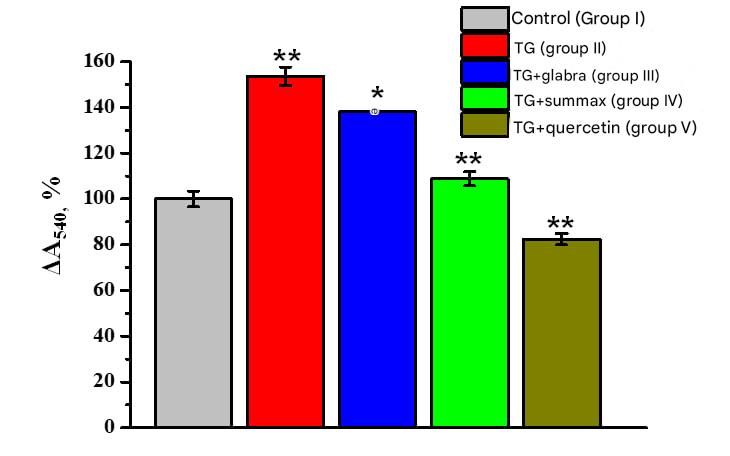 | Figure 2. Effects of glabra, summax polyphenols and quercetin flavonoid on liver mitochondrial dysfunction (mPTP permeability) in CCl4-induced toxic hepatitis (*p<0.05; **p<0.01; n=5) |
One of the compounds that restore liver cells in toxic hepatitis is the flavonoid quercetin, which in experiments also restores mitochondrial dysfunction. In our experiments, the effect of the hepatoprotective compound quercetin, available as group V, on the suppression of rat liver mitochondria was compared with glabra and summax polyphenols. Group V rats with toxic hepatitis were given a dose of 30 mg/kg of the flavonoid quercetin for 15 days, and mitochondria were extracted from their livers. According to the obtained results, it was found that the Ca2+ ion-dependent swelling of liver mitochondria of rats with toxic hepatitis V was inhibited by 46.3% compared to the indicators of group II (Fig. 1). So, quercetin flavonoid has been found to be stronger than glabra and summax polyphenol in inhibiting permeability of liver mitochondria in hepatitis conditions.An increase in the load of Ca2+ ions in mitochondria causes the mPTP to open. Many types of agents have been found that cause mPTP opening. For example, pro-oxidants, inducers, stress factors and hakazoo. However, mPTP inhibitors are rare. In the experiments, there is a classic inhibitor that inhibits the opening of the mPTP, that is, mitochondrial strangulation. This inhibitor is cyclosporine A, which inhibits mitochondrial shunting by activating cyclophilin D, a component of mPTP opening. cyclosporine A helps maintain mitochondrial integrity by inhibiting mPTP opening, maintains ATF production, and reduces cell death [21].In the above experiments, we were prompted to conduct additional experiments in order to clarify whether the inhibitory effect of polyphenolic compounds on the suppression of liver mitochondria in toxic hepatitis was actually caused by blocking the mPTP opening. In subsequent experiments, the effect of cyclosporine A on the size of mitochondria isolated from the livers of rats with healthy, toxic hepatitis and polyphenol-corrected toxic hepatitis was studied. According to the obtained results, in rats of the control group (healthy) the mitochondrial damage under the influence of Ca2+ ions was recorded as 100%. It was found that 100% inhibition of liver mitochondria of the control group of rats under the influence of Ca2+ ions and in the presence of mPTP inhibitor cyclosporine A in the incubation medium was 100% (Fig. 3).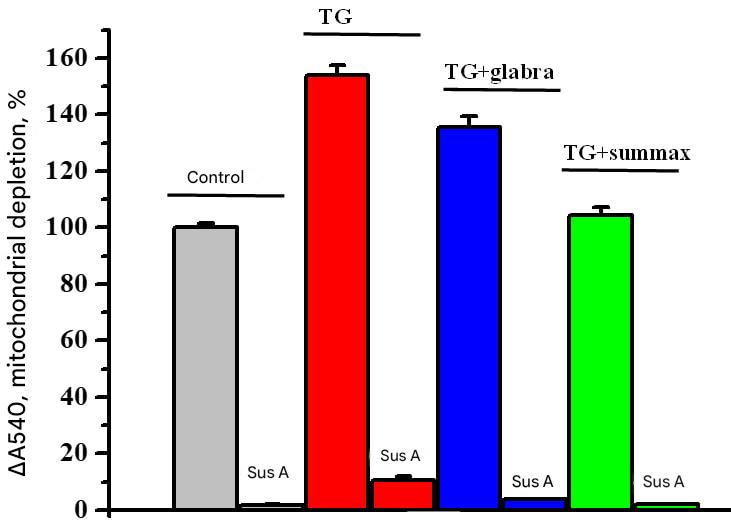 | Figure 3. Staging of rat liver mitochondria in toxic hepatitis under the influence of Ca2+ ions and in the presence of 1 µM concentration of mPTP inhibitor cyclosporin A in the incubation medium |
However, glabra and summax polyphenols were found to inhibit mitochondrial destruction in toxic hepatitis compared to group II indicators in the presence of cyclosporin A (Fig. 4). Therefore, in the presence of cyclosporin, the inhibition of mitochondrial function under the influence of polyphenols may have occurred through the activation of the mPTP component cyclophilin D protein.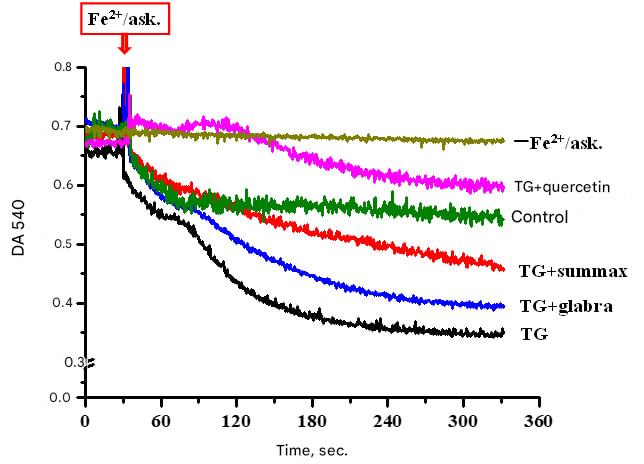 | Figure 4. Effects of glabra, summax and quercetin flavonoids on Fe2+/ascorbate-induced LPO process of rat liver mitochondria under toxic hepatitis conditions. Original record taken with V-5000 spectrophotometer |
In the conditions of toxic hepatitis, it is possible to increase the swelling of liver mitochondria, hydrolyze the lipid structures of the inner and outer membranes and lead to peroxidation. In the conditions of toxic hepatitis, mPTP conformation opening of liver mitochondria can also be realized by peroxide oxidation of membrane lipids. Further experiments were conducted in order to determine the LPO of the inner and outer membrane of the liver mitochondria in toxic hepatitis and to determine the effect of polyphenol compounds on the amount of the final product MDA.One of the main changes in cell metabolism is the activation of LPO. Under normal conditions, the amount of LPO products remains in the tissues at a certain level, because they are necessary for the normal functioning of the body. They contribute to the destruction of the destroyed components of the respiratory chain in mitochondria and activate the processes. It participates in cell proliferation and differentiation, ion transport, regulation of cell membrane permeability, destruction of damaged chromosomes, etc. LPO in the cell is carried out by the active form of oxygen [7,9].A constant level of LPO products is maintained by the antioxidant system of the cell. Under normal conditions, molecular oxygen is a component of the reaction that produces water molecules. The catalyst of the reaction is cytochrome oxidase, which contributes to the addition of four electrons to the oxygen molecule. LPO causes disruption of cell membrane components and subsequent membrane integrity, which is accompanied by various pathological processes, in particular, inflammation, neurodegenerative diseases, viral and toxic hepatitis, etc. [11,15]. As a result of LPO, the level of ROS formation in mitochondria increases.Bioactive compounds can stop the synthesis of ROS, activate antioxidant enzymes or chelate metal ions responsible for the formation of free radicals, purify the cell from ROS. One of these compounds is polyphenolic compounds, which are distinguished from other compounds by their high activity in experiments. In this experiment, the effects of glabra, summax polyphenols on Fe2+/ascorbate-induced LPO of rat liver mitochondria under conditions of toxic hepatitis were compared with quercetin (Figure 4). In experiments, Fe2+/ascorbate is often used to generate the mitochondrial membrane LPO process. In vivo experiments, Fe2+/ascorbate was used to induce LPO in liver mitochondrial membrane. According to the obtained results, it was found that LPO induced by Fe2+/ascorbate of liver mitochondria of group III rats with toxic hepatitis injected with glabra polyphenol was inhibited by 16.8% compared to group II with toxic hepatitis. Glabra polyphenol reduced Fe2+/ascorbate-induced LPO of rat liver mitochondria under conditions of toxic hepatitis. It was found that the LPO of the liver mitochondria of group IV rats treated with summax polyphenol pharmacotherapy with toxic hepatitis was inhibited by 30.6% compared to the pathological group (group II) (Fig. 4). Thus, it was shown that summax polyphenol is stronger than glabra polyphenol in reducing LPO of the liver mitochondria membrane in toxic hepatitis. As a result of administration of quercetin flavonoid to group B of the experiment with toxic hepatitis, it was found that LPO induced by Fe2+/ascorbate in liver mitochondria was inhibited by 75.6% compared to the results of group II (Fig. 5). According to the obtained results, it was found that LPO induced by Fe2+/ascorbate of liver mitochondria of group III rats with toxic hepatitis injected with glabra polyphenol was inhibited by 16.8% compared to group II with toxic hepatitis. Glabra polyphenol reduced Fe2+/ascorbate-induced LPO of rat liver mitochondria under conditions of toxic hepatitis. It was found that the LPO of the liver mitochondria of group IV rats treated with summax polyphenol pharmacotherapy with toxic hepatitis was inhibited by 30.6% compared to the pathological group (group II) (Fig. 5). Thus, it was shown that summax polyphenol is stronger than glabra polyphenol in reducing LPO of the liver mitochondria membrane in toxic hepatitis. As a result of administration of quercetin flavonoid to group B of the experiment with toxic hepatitis, it was found that LPO induced by Fe2+/ascorbate in liver mitochondria was inhibited by 75.6% compared to the results of group II (Fig. 5).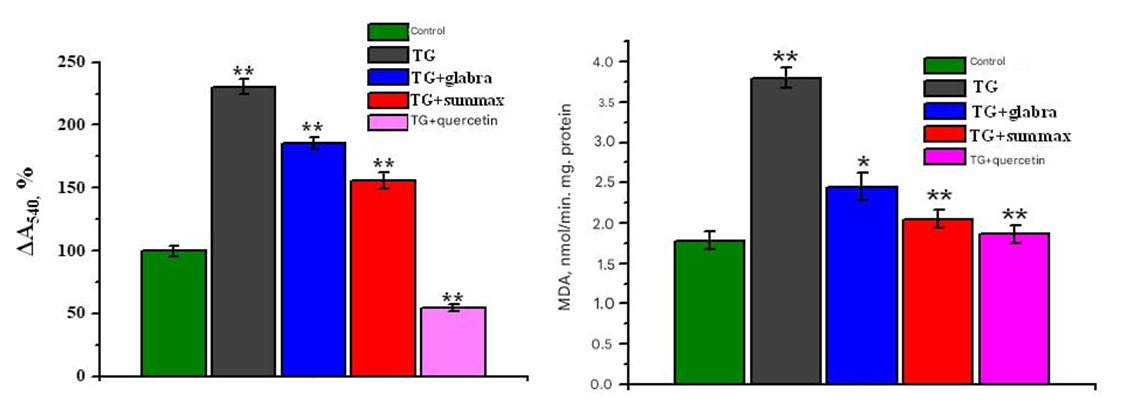 | Figure 5. A). Effects of glabra, summax and quercetin flavonoids on Fe2+/ascorbate-induced LPO process of rat liver mitochondria under toxic hepatitis conditions. B). Effects of glabra, summax, and quercetin on the amount of MDA formed during LPO in rat liver mitochondria in a model of toxic hepatitis. (**p<0.01; n=5) |
The obtained results revealed that quercetin, glbara and summax polyphenols had an inhibitory effect on the LPO rate of the liver mitochondrial membrane under conditions of toxic hepatitis. Among them, quercetin flavonoid obtained as a standard hepatoprotector, antioxidant compound showed a more active inhibitory effect compared to glabra and summax polyphenols. Acceleration of LPO process as a result of CCl4-induced toxic hepatitis in rat liver mitochondria caused an increase in MDA content. Administration of glabra, summax polyphenols, and quercetin flavonoids to toxic hepatitis models for the purpose of correcting the LPO process for 15 days caused a decrease in MDA, which in turn showed their antioxidant properties.
5. Conclusions
In CCl4-induced toxic hepatitis, 15 days of pharmacotherapy with glabra 40 mg/kg, sumax polyphenol 32 mg/kg, and quercetin 30 mg/kg body weight for 15 days corrects liver mitochondrial dysfunction. Sumax polyphenol and quercetin flavonoid partially close PTP of rat liver mitochondria under conditions of toxic hepatitis, reduce membrane permeabilization and increase mitoKATF-channel activity. In the conditions of toxic hepatitis, glbara polyphenol weakly inhibits the death of liver mitochondria. Quercetin's astringent properties have been found to be stronger than glabra and summax polyphenols.
References
| [1] | Ishankhodjaev T. et al. Study on Effects of Liposomal Quercetin on Biochemical Parameters of the Nigrostriatal System of Rats with Experimentally Induced Neurodegenerative Disease // Annals of the Romanian Society for Cell Biology. – 2021. – С. 6128-6143. |
| [2] | Mukhammadjon M. et al. The effect of NGF on indicators of the antioxidant system in rat brain tissue // Universum: химия и биология. – 2021. – №. 9 (87). – С. 82-86. |
| [3] | Saatov T. et al. Antioxidant and hypoglycemic effects of gossitan // Endocrine Abstracts. – Bioscientifica, 2019. – Т. 63. |
| [4] | Saatov T. et al. Study on hypoglycemic effect of polyphenolic compounds isolated from the Euphorbia L. plants growing in Uzbekistan // Endocrine Abstracts. – Bioscientifica, 2020. – Т. 70. |
| [5] | Mamadalieva N. I., Mustafakulov M. A., Saatov T. S. The effect of nerve growth factor on indicators of the antioxidant system in rat brain tissue // eurasian union of scientists. series: medical, biological and chemical sciences Uchrediteli: ООО" Logika. – 2021. – №. 11. – p. 36-40. |
| [6] | Saatov T. et al. Study on antioxidant and hypoglycemic effects of natural polyphenols in the experimental diabetes model // Endocrine Abstracts. – Bioscientifica, 2018. – Т. 56. |
| [7] | Mustafakulov M. et al. Determination of antioxidant properties of L-cysteine in the liver of alloxan diabetes model rats // International Journal of Contemporary Scientific and Technical Research. – 2023. – №. Special Issue. – p. 47-54. |
| [8] | Mamadalieva N. I., Mustafakulov M. A., Saatov T. S. The Effect of Nerve Growth Factor on Antioxidant System Indicators in Rat Brain Tissues //Environmental Science. – 2021. – Т. 723. – p. 022021. |
| [9] | Mustafakulov M.A. Plasmid Types and the Importance of Plasmids in Cell Engineering // Best Intellectual Studies // – 2024. – Т. 17. – №. 3. – p. 63-67. |
| [10] | Mallayeva M., Mustafakulov M. // The Effect of Polyphenols on Peroxidation Products of Lipids in Toxic Hepatitis // International Journal of scientific and Applied Research. – 2024. – Т. 1. – №. 3. – p. 75-78. |
| [11] | Mustafakulov M. et al. // Analysis of the Amount of Polyphenols Present in the Morphological Organs of Plants Belonging to the Euphorbiaceae Family // International Journal of scientific and Applied Research. – 2024. – Т. 1. – №. 3. – p. 66-69. |
| [12] | Saatov T. et al. Antioxidant and hypoglycemic effects of gossitan // Endocrine Abstracts. – Bioscientifica, 2019. – Т. 63. |
| [13] | Saatov T. et al. Study on antioxidant and hypoglycemic effects of natural polyphenols in the experimental diabetes model // Endocrine Abstracts. – Bioscientifica, 2018. – Т. 56. |
| [14] | Irgasheva S. et al. Study on compositions of lipids in tissues of rats with alimentary obesity // Endocrine Abstracts. – Bioscientifica, 2019. – Т. 63. |
| [15] | Mustafakulov M. et al. Determination of antioxidant properties of l-cysteine in the liver of alloxan diabetes model rats // International Journal of Contemporary Scientific and Technical Research. – 2023. – №. Special Issue. – С. 47-54. |
| [16] | Mukhtorov A. A. et al. Changes in the dynamics of Ca2+ transport in the brain membrane of rats with Alzheimer's disease and their correction with polyphenols // SGS-Engineering & Sciences. – 2024. – Т. 2. – №. 3. |
| [17] | Saatov T. et al. Assessment of hypoglycemic properties of extracts from some medicinal plants in the experimental diabetes model // Endocrine Abstracts. – Bioscientifica, 2022. – Т. 81. |
| [18] | Khoshimov N. N. et al. Rеgulation and corrеction with thе hеlp of polуphеnols to changе thе dуnamics of transport of Ca2+ NMDA-rеcеptors in thе statе of Alzhеimеr's disеasе //SGS-Engineering & Sciences. – 2024. – Т. 2. – №. 3. |
| [19] | Mukhtorov A. A. et al. Changes in the regulation of Ca2+ signaling in synaptosomes in Alzheimer's disease // SGS-Engineering & Sciences. – 2024. – Т. 2. – №. 3. |
| [20] | Irgasheva S. et al. Study on compositions of lipids in tissues of rats with alimentary obesity // Endocrine Abstracts. – Bioscientifica, 2019. – Т. 63. |
| [21] | Makhramovna M. M., Abduvaliyevich M. M. Effect of polyphenol compounds on liver mitochondral atgf-dependent potassium channel activity in CCl4-induced toxic hepatitis // Next Scientists Conferences. – 2025. – С. 61-64. |





 Abstract
Abstract Reference
Reference Full-Text PDF
Full-Text PDF Full-text HTML
Full-text HTML
